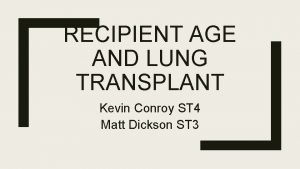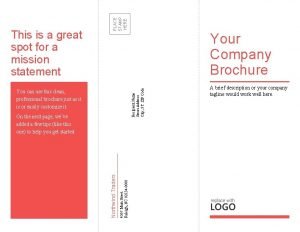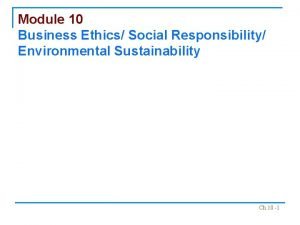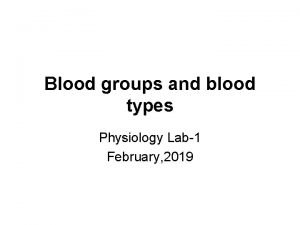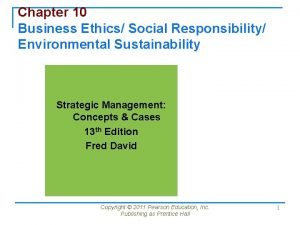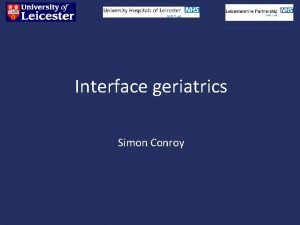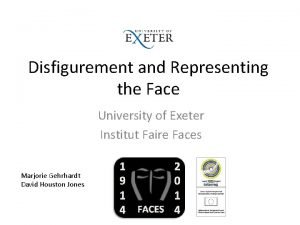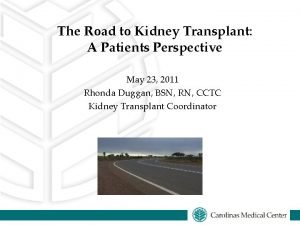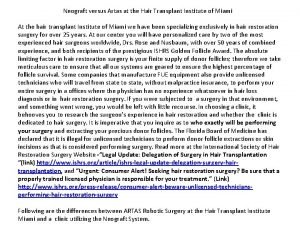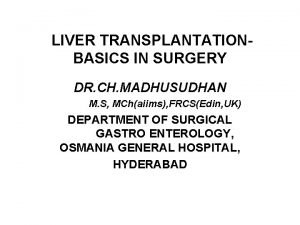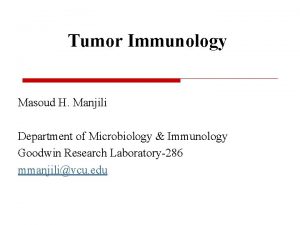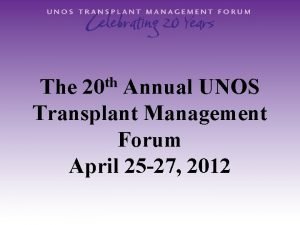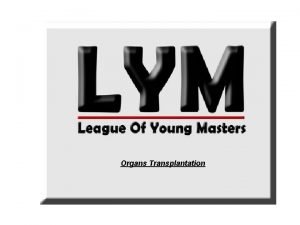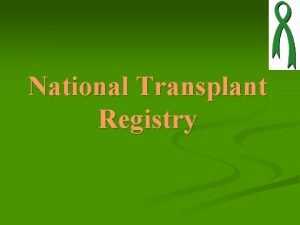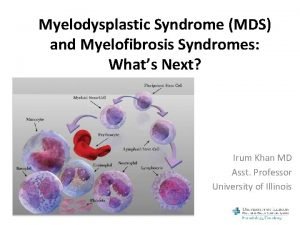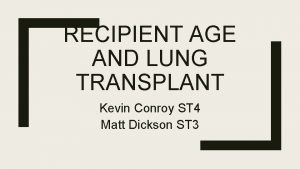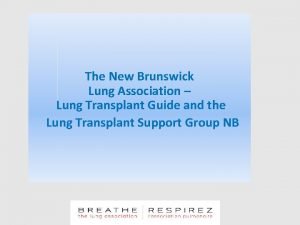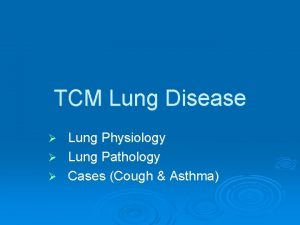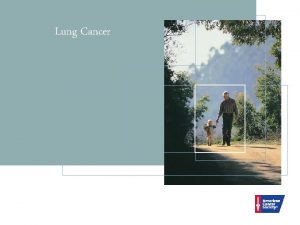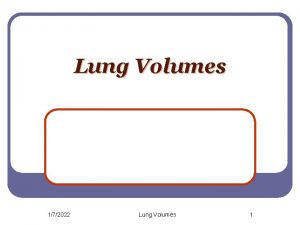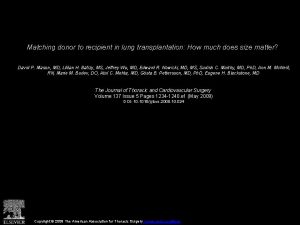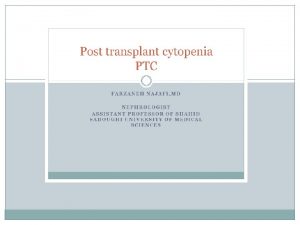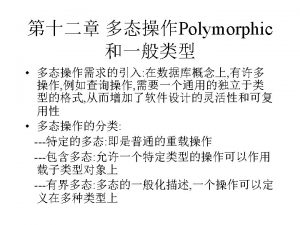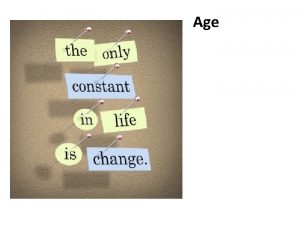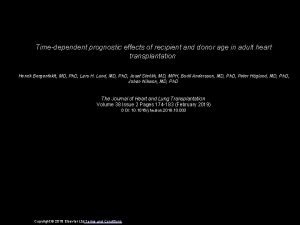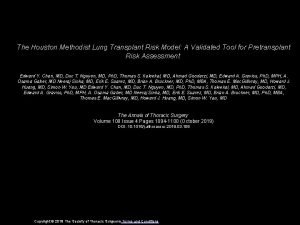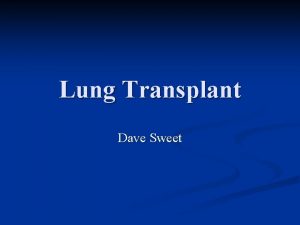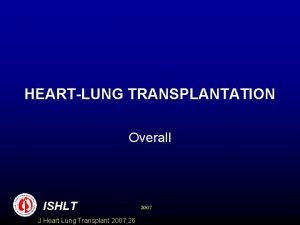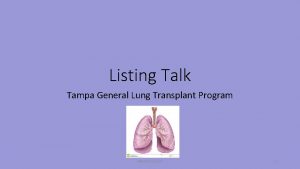RECIPIENT AGE AND LUNG TRANSPLANT Kevin Conroy ST





























- Slides: 29

RECIPIENT AGE AND LUNG TRANSPLANT Kevin Conroy ST 4 Matt Dickson ST 3

Introduction ■ Criteria for lung transplantation ■ Assessment process ■ Ethical considerations ■ Arguments for age limitation ■ Arguments against age limitation

ISHLT Guidance for Lung Transplant Should be considered for patients with chronic, end-stage lung disease who meet following general criteria: 1. High (>50%) risk of death from lung disease within 2 years if lung transplantation is not performed. 2. High (>80%) likelihood of surviving at least 90 days after lung transplantation. 3. High (>80%) likelihood of 5 -year post-transplant survival from a general medical perspective provided that there is adequate graft function.

Absolute: ■ ■ ■ Contraindications Recent history of malignancy Untreatable significant dysfunction of other major organ Uncorrected/untreatable atherosclerotic disease with end-organ ischaemia/dysfunction Acute medical instability Uncorrected hypocoagulopathy Chronic infection with highly virulent/pan-resistant organisms Significant chest wall/spinal deformity BMI >35 Poor compliance to medical therapy Untreated psychiatric/psychological conditions Absence of adequate/reliable social support system Substance abuse or dependence

Contraindications Relative: ■ Age >65 years for single lung transplant, >60 for bilateral ■ BMI <18 or >30 ■ Severely deconditioned with poor rehab potential ■ Colonisation with certain pathogens ■ HIV, Hepatitis B and C ■ Severe, symptomatic osteoporosis ■ Extensive prior chest surgery/lung resection ■ Mechanical ventilation and/or extracorporeal life support ■ Significant atherosclerotic disease

Assessment Process Height, weight and BMI >17, <30 Bloods – FBC, Creatinine clearance, LFT, tissue typing and antibody screen Virology – HIV, Hep B, Hep C, CMV Sputum MCS Urine MSU

Assessment Imaging ■ ■ ■ ■ CXR Latest Images DEXA Perfusion (Q) scan Echocardiogram ECG Angiogram / CT angiogram Ultrasound abdomen/ liver

Assessment ■ PFTS - spirometry, TLC, DLCO ■ 6 MWT – assess exercise capacity ■ Social work / family support

Common issues ■ Lack of recent imaging ■ Deconditioning ■ BMI outside tolerance ■ Outstanding coronary artery assessment

Ethical considerations in organ transplants Medical ethics: Beneficence, non-maleficence, autonomy and justice Distributive justice: ■ Only becomes an issue when scarce resources ■ Thinks about group ethic rather than patient-centred ethic ■ Equal access – Distribution free of bias ■ Maximum benefit – Maximise successful transplants

Controversy surrounding Age Criteria § § § <60 for bilateral lung transplant <65 for single lung transplant Age has been revisited periodically Contradictory evidence Increased complication rates and decreased survival rates among older vs possibility of benefiting younger persons with better outcomes § Other studies show equivocal outcomes § Chronological age vs. Physiological age

Arguments for Age Criteria

ISHLT Registry Report 2015 International heart and lung transplant registry collecting data since 1983 Tracks morbidity and mortality post-transplant ISHLT registry report 2015 summarised data from 51, 440 adult lung transplants 242 Lung transplant centres and 174 Heart-Lung transplant centres provided Report encompassed data up to June 30 th 2014

Findings of the 2015 report ■ 45, 542 adults underwent primary lung transplantation between 1990 and June 2013 ■ Median survival of 5. 7 years ■ Survival rates of 89% at 3 months, 80% at 1 year, 65% at 3 years, 54% at 5 years and 31% at 10 years ■ Those surviving at 1 year had median survival of 7. 9 years ■ Better survival in bilateral lung transplants (7. 1 years vs 4. 5 for single) ■ Better survival in latest era (i. e. between 2009 -2013) ■ Survival also varied for different indications, sex as well as age The Registry of the International Society for Heart and Lung Transplantation: Thirty-second Official Adult Lung and Heart-Lung Transplantation Report--2015; Focus Theme: Early Graft Failure. Yusen RD, Edwards LB, Kucheryavaya AY, Benden C, Dipchand AI, Goldfarb SB, Levvey BJ, Lund LH, Meiser B, Rossano JW, Stehlik J. J Heart Lung Transplant. 2015; 34(10): 1264

Arguments for current age criteria ■ Multiple risk factors for death identified in 17, 755 adult transplants between 2001 -2013 ■ Highest hazard ratios were transplant centre volume and recipient age ■ Increased risk of 1 year post-transplant death began at ~55 years ■ Rises exponentially thereafter

Hazard ratio for mortality within the first post-transplant year for adult lung transplant recipient age and center volume (transplants: January 2001–June 2013). The dashed lines represent 95% confidence intervals.

ISHLT Registry Report 2013 – focus theme: age ■ 66% of recipients for lung transplant were between ages of 45 -65 ■ Since 1985, median age of recipient increased from 45 to 55 ■ 2006 -2012, 10% aged >65, 3% >70 compared with 3% and 0. 3% respectively between 2000 -20052 ■ Mortality rates differed depending on era (most recent, better survival) ■ Increased age of recipient mainly in ILD and COPD (excluding A 1 ATD) ■ Older sub-groups generally had lower long-term survival and Yusen RD, Christie JD, Edwards LB, et al. for the International Society of Heart and Lung Transplantation. Registry of the International Society for Heart and Lung Transplantation: 30 th adult lung younger and heart-lung transplant report– 2013; higher long-term complication rates than sub-groups focus theme: age. J Heart Lung Transplant 2013; 32: 965 -78

ISHLT Registry Report 2013 – focus theme: age ■ Mortality also dependent on indication for transplant: – 3 month mortality rates highest in IPAH (22%), lowest in non-A 1 ATD COPD (9%) – Median survival for those surviving to 1 year highest for CF (10. 5), IPAH (10) and lowest for ILD (7. 0) and non-A 1 ATD COPD (6. 9) ■ Median survival for transplants between 1990 and 2011: – >65 years - 3. 6 years – 60 -65 years - 4. 5 years – 50 -59 years - 5. 3 years – 35 -49 years - 6. 7 years – 18 -34 years - 6. 5 years

ISHLT Registry Report 2013 – focus theme: age ■ Five year survival rates: – >65 years – 38% – 60 -65 years – 46% – 50 -59 years – 52% – 35 -49 years – 57% – 18 -34 years – 55% ■ Interaction between age and indication for transplant – Older recipients within each diagnostic group had worse survival – Non-A 1 ATD COPD had better overall survival compared to ILD – 18 -49: 6. 4 years vs 5. 7 years – 50 -65: 5. 4 years vs 4. 3 years – >65: 3. 7 vs 3. 8 years

Why does increased age lead to poorer outcomes? ■ Chronic kidney disease ■ Diabetes ■ Cardiovascular complications ■ Thromboembolic disease ■ Malignancy

Arguments against Age Criteria

Age isn’t a barrier ■ Distributive justice of finite resource ■ Aging population ■ Shrinking health budget § Improving health in older age § Delaying pension / working longer § Feasibility and better outcomes

Age isn’t a barrier ■ ISHLT guidance suggests ‘physiological’ age of <65 single lung, <60 double lung tx. ■ No absolute age limit ■ ISHLT registry – cumulative – doesn’t reflect newer data ■ Personalized care

Age isn’t an Barrier ■ Delayed pension ■ Societal roles ■ Increased expectation ■ Equality ■ The aim of transplant

Age isn’t a barrier Mahidhara, Bastani et al 2008 ■ No significant difference in survival at 3 years <65 vs >65 ■ Reduced (p=0. 16) survival 1 -12 month period – infection ■ Immunosenescence of age – tx not tailored to older age ■ Freedom from BOS lower at 12/12 but not significant overall But >65 1. 76% SLTx 2. Basiliximab induction c. f ATG 3. Non standardized donor organs Mahidhara et al. Lung transplantation in older patients? Journal of thoracic and cardiovascular surgery 2008

Age isn’t a barrier ■ 182 - 52 >60 years old ■ No significant difference in survival over 5 years (p=0. 61) ■ Mortality slightly worse before 30 days for >60 – probability curves taken from beyond 30 days. ■ In hospital mortality 12% c. f 7% in under 60. ■ All over 65 had SLT Smith et al. Lung transplantation in over 60 years and older: results, complications and outcomes. Journal of the society of thoracic surgeons. 2006

Age isn’t a barrier ■ 2 year period 268 lung tx, 47% aged over 60 ■ No significant difference in survival at 1, 12 and 36 months <60, 60 -65, >65. ■ Similar rates of significant bacterial infecgtion ■ Malignancy and drug toxicity more likely in >65 (p=0. 004), (0. 03) than 60 -65 ■ Rejection more common 60 -65 group c. f >65 Vadnerkar et al Age-specific complications among lung transplant recipients 60 years and older. JHLT 2011

Age isn’t a barrier ■ Improving experience ■ Aging population ■ Social responsibility ■ Acceptable outcomes in transplant Careful patient selection

Any Questions?
 Kevin conroy finite
Kevin conroy finite Jay conroy cnn
Jay conroy cnn Iron age bronze age stone age timeline
Iron age bronze age stone age timeline Iron age bronze age stone age timeline
Iron age bronze age stone age timeline Recipient company name
Recipient company name It is a gift bestowed to influence a recipient’s conduct.
It is a gift bestowed to influence a recipient’s conduct. Why is type ab a universal recipient
Why is type ab a universal recipient Blood group compatibility chart
Blood group compatibility chart A gift bestowed to influence a recipient's conduct:
A gift bestowed to influence a recipient's conduct: Which medal of honor recipient is described
Which medal of honor recipient is described Ciara juliet
Ciara juliet Louis rickinson facts
Louis rickinson facts Jarrod conroy
Jarrod conroy Paul steven conroy
Paul steven conroy Nathan conroy
Nathan conroy Elva conroy
Elva conroy Elva conroy
Elva conroy Cormac conroy
Cormac conroy Simon conroy
Simon conroy Face transplant
Face transplant Disadvantage of kidney transplant
Disadvantage of kidney transplant Slk medical abbreviation transplant
Slk medical abbreviation transplant Diet after bone marrow transplant
Diet after bone marrow transplant Neograft hair transplant in miami
Neograft hair transplant in miami Heterotopic liver transplant meaning
Heterotopic liver transplant meaning Oncogens
Oncogens Unos transplant management forum
Unos transplant management forum Face transplant
Face transplant National transplant registry malaysia
National transplant registry malaysia Allogeneic stem cell transplant
Allogeneic stem cell transplant
